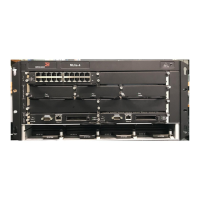Examples
For the Syslog default action:
Mar 4 20:33:57:A:System: LP15/TM0: All ports down due to TM XPP link down
Mar 4 20:33:57:I:System: Interface ethernet 15/4, state down – TM XPP link down
Mar 4 20:33:57:I:System: Interface ethernet 15/3, state down – TM XPP link down
Mar 4 20:33:57:I:System: Interface ethernet 15/2, state down – TM XPP link down
Mar 4 20:33:57:I:System: Interface ethernet 15/1, state down – TM XPP link down
For the SNMP trap default action:
Health Monitoring: LP15: all ports down due to TM- XPP NIF link down
For the Syslog line card reset action:
Mar 4 20:33:57: D:System: Module reset in slot 1, triggered by TM Health Monitoring
Mar 4 20:33:57: D:System: TM Health Monitoring detects an issue in slot 1 ppcr 1 TM XPP link down
For the SNMP trap line card action:
Type- debugging
System: Module reset in slot 1, triggered by TM Health Monitoring
History
Release version Command history
R05.7.00b This command was introduced.
Using alarms to collect and monitor device status
Beginning in Brocade NetIron R05.3.00, the software keeps two logs; one of hardware status currently available to the system, and
another of hardware status history. The current alarm log keeps only entries for current information; when a hardware status is no longer
valid, the entry is cleared. The alarm history log keeps a record of hardware statuses even after the status has changed. The alarm history
log enables you to quickly determine trouble areas in a system. For example, by accessing the history, you can quickly determine if a
problem is occurring too frequently and might require action.
Each hardware status entry is called an alarm and is
classied by severity assigned by the software. The software categorizes alarms in
the following levels:
• Critical - A condition that will cause damage to the system. A condition that causes a trac outage on multiple ports.
• Major - A condition that causes trac outage on single ports or might cause damage to the system.
• Minor - A condition that should be investigated but will not damage the system.
By default, all hardware status alarm levels of major severity and higher are logged, though you can congure the status alarm levels sent
to both alarm logs (current and history). You can use the show alarm command to view the current status on a device, or a logged history
of hardware alarms. To change the levels of alarms sent to the alarm logs, refer to Conguring Alarm History Buer Size on page 229.
The alarms are specic to hardware status, whereas the syslog records information for software events. Alarms can also be congured on
very specic terms such as a failed temperature sensor on a single interface module.
To take advantage of this feature, you should rst set the alarm history buer size. This is optional, but you have the option to limit how
many entries are stored in the alarm history so you can free up space for other resources. Refer to Conguring Alarm History Buer Size
on page 229 for more information.
Using alarms to collect and monitor device status
Brocade NetIron MLXe Series Hardware Installation Guide
228 53-1004203-04

